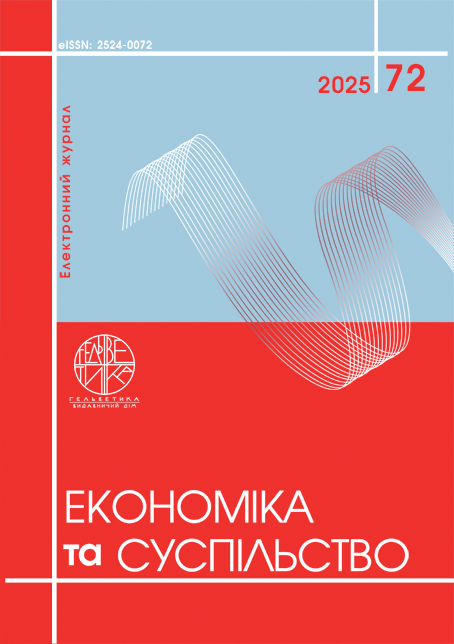THEORETICAL APPROACHES TO THE FORMATION OF INNOVATION POLICY OF THE US STATE
Abstract
The purpose of the article is to provide a comprehensive analysis of the US innovation policy, its theoretical basis, practical tools and mechanisms for its implementation, and to assess its impact on the country's economic growth and competitiveness. The relevance of the topic is driven by increased global competition, accelerating technological development, and the growing role of innovation in ensuring national security and economic prosperity. The study is based on an integrated approach that combines several methods: theoretical analysis of the main concepts of innovation policy (national innovation system, open innovation, triple helix model, public-private partnership); comparative analysis of different approaches to financing research and development (grant funding, tax incentives, venture capital investments); statistical analysis of innovation indicators (R&D expenditures, number of patents, venture capital activity); and a case study method that allows to determine the role of innovation in the country's economy. The results of the study show that the US innovation policy is characterized by complexity and diversity. It covers a wide range of instruments: from direct government funding of basic and applied research through national research funds (NSF, DARPA, NIH) to indirect methods of stimulating innovation, such as tax incentives for companies engaged in R&D and creating a favorable environment for venture capital development. An important role is played by public-private partnerships, which allow combining the resources and competencies of the public and private sectors to implement large-scale innovation projects. The practical value of the article lies in identifying the key factors that ensure the effectiveness of the US innovation policy, as well as in formulating recommendations for its improvement in the context of current challenges. In particular, the author emphasizes the need to increase investment in basic research, promote technology transfer, support innovation clusters, attract talented professionals, adapt the education system and strengthen intellectual property protection. The results of the study may be useful for other countries in developing and improving their own innovation development strategies aimed at increasing competitiveness and ensuring sustainable economic growth.
References
Acemoglu D., Robinson J. A. The Narrow Corridor. New York: Penguin Press, 2019. P. 310–318.
Atkinson R. D., & Ezell, S. J. Innovation Economics: The Race for Global Advantage. New Haven: Yale University Press, 2019. P. 55–63.
Brookings Institution. The Role of Federal Funding in American Innovation. Washington, 2023. P. 78–85.
Chesbrough H. Open Innovation. Boston: Harvard Business School Press, 2003. P. 78–85.
Council on Foreign Relations (CFR). Innovation Policy and Global Competition. New York. 2022. P. 25–32.
Edler J., Fagerberg J. Innovation policy: what, why, and how. Oxford Review of Economic Policy, 33(1). 2017. P. 2-23.
European Innovation Council (EIC) The U.S. and EU: Comparative Analysis of Innovation Policy. Brussels, 2023. P. 55–63.
Gruber J., Johnson S. Jump-Starting America. New York: PublicAffairs, 2019. P. 110–118.
Harvard Business School. The American Model of Innovation Regulation. Cambridge, 2023. P. 201–210.
Lane J.. The social value of science and its implications for science policy. In Handbook of Science and Technology Studies (4th ed., pp. 973-996). MIT Press. 2020.
Maskus K. E. Intellectual property rights in the global economy. Institute for International Economics. 2000.
Mazzucato M. The entrepreneurial state: Debunking public vs. private sector myths. Anthem Press. 2013.
Mazzucato M. The Entrepreneurial State. London: Anthem Press. 2018. P. 40–47.
National Academy of Sciences. Innovation and Economic Growth in the U.S. Washington. 2023. P. 110–118.
National Science Foundation (NSF). Annual Report on U.S. Innovation Funding. Washington. 2023. P. 12–18.
Nelson R. R. National Innovation Systems: A Comparative Analysis. Oxford: Oxford University Press. 1993. P. 25–32.
OECD. U.S. R&D Investment Strategies. Paris. 2023. P. 40–47.
Perez C. Technological Revolutions and Financial Capital. Cheltenham: Edward Elgar. 2021. P. 201–210.
Schumpeter J. A. Capitalism, Socialism, and Democracy. New York: Harper. 1942. P. 12–18.
U.S. Department of Commerce. Annual Review of Industrial Innovation Policies. Washington. 2023. P. 310–318.
Acemoglu D., Robinson J. A. (2019). The Narrow Corridor. New York: Penguin Press. P. 310–318.
Atkinson R. D., & Ezell, S. J. (2019). Innovation Economics: The Race for Global Advantage. New Haven: Yale University Press. P. 55–63.
Brookings Institution (2023). The Role of Federal Funding in American Innovation. Washington. P. 78–85.
Chesbrough H. (2003). Open Innovation. Boston: Harvard Business School Press. P. 78–85.
Council on Foreign Relations (CFR) (2022). Innovation Policy and Global Competition. New York. P. 25–32.
Edler J., Fagerberg J. (2017). Innovation policy: what, why, and how. Oxford Review of Economic Policy, 33(1), 2-23.
European Innovation Council (EIC) (2023). The U.S. and EU: Comparative Analysis of Innovation Policy. Brussels. P. 55–63.
Gruber J., Johnson S. (2019). Jump-Starting America. New York: PublicAffairs. P. 110–118.
Harvard Business School (2023). The American Model of Innovation Regulation. Cambridge. P. 201–210.
Lane J. (2020). The social value of science and its implications for science policy. In Handbook of Science and Technology Studies (4th ed., pp. 973-996). MIT Press.
Maskus K. E. (2000). Intellectual property rights in the global economy. Institute for International Economics.
Mazzucato M. (2013). The entrepreneurial state: Debunking public vs. private sector myths. Anthem Press.
Mazzucato M. (2018). The Entrepreneurial State. London: Anthem Press. P. 40–47.
National Academy of Sciences (2023). Innovation and Economic Growth in the U.S. Washington. P. 110–118.
National Science Foundation (NSF) (2023). Annual Report on U.S. Innovation Funding. Washington. P. 12–18.
Nelson R. R. (1993). National Innovation Systems: A Comparative Analysis. Oxford: Oxford University Press. P. 25–32.
OECD (2023). U.S. R&D Investment Strategies. Paris. P. 40–47.
Perez C. (2021). Technological Revolutions and Financial Capital. Cheltenham: Edward Elgar. P. 201–210.
Schumpeter J. A. (1942). Capitalism, Socialism, and Democracy. New York: Harper. P. 12–18.
U.S. Department of Commerce (2023). Annual Review of Industrial Innovation Policies. Washington. P. 310–318.

This work is licensed under a Creative Commons Attribution 4.0 International License.


